Quiche Lorraine
This post may contain affiliate links. Read my full disclosure policy.
Richly flavored with Gruyère cheese and smoky bacon, quiche Lorraine is one of the most satisfying dishes imaginable.
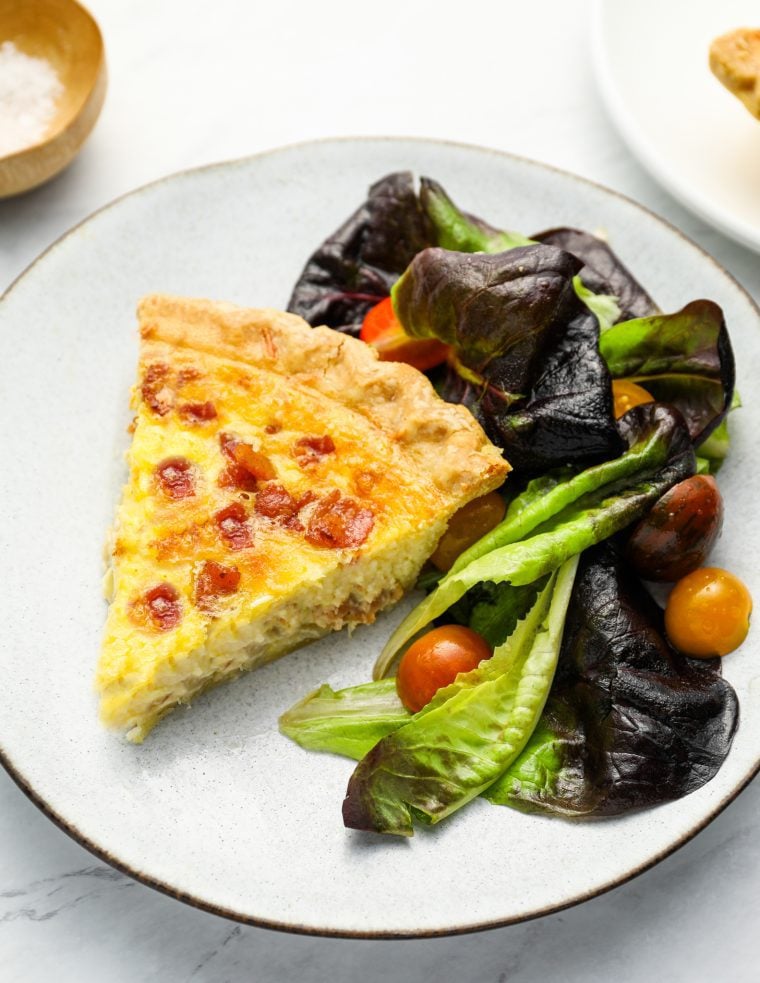
During my college years, I spent a semester studying abroad in Tours, France, a charming university town located an hour away from Paris. One of my daily rituals was visiting a local boulangerie for lunch. I’d treat myself to a mini quiche Lorraine, then savor every bite while strolling back to class through the winding, cobbled streets. While I can’t remember much about my courses, the memory of that simple pleasure still lingers to this day.
Named after the region of France where it originated, quiche Lorraine is is one of the most iconic French quiches and also one of the most satisfying dishes imaginable. Richly flavored with smoky bacon, nutty Gruyère cheese, and shallots, it’s ideal for brunch, lunch, or dinner, especially paired with a green salad and crisp white wine.
Table of Contents
“This is hands down, the BEST quiche Lorraine recipe ever! As a personal chef, I am asked to make dishes that reheat well – this one does, but it’s also exceptional when served fresh out of the oven…People always tell me it’s the best quiche they’ve ever tasted!”
What You’ll Need To Make Quiche Lorraine
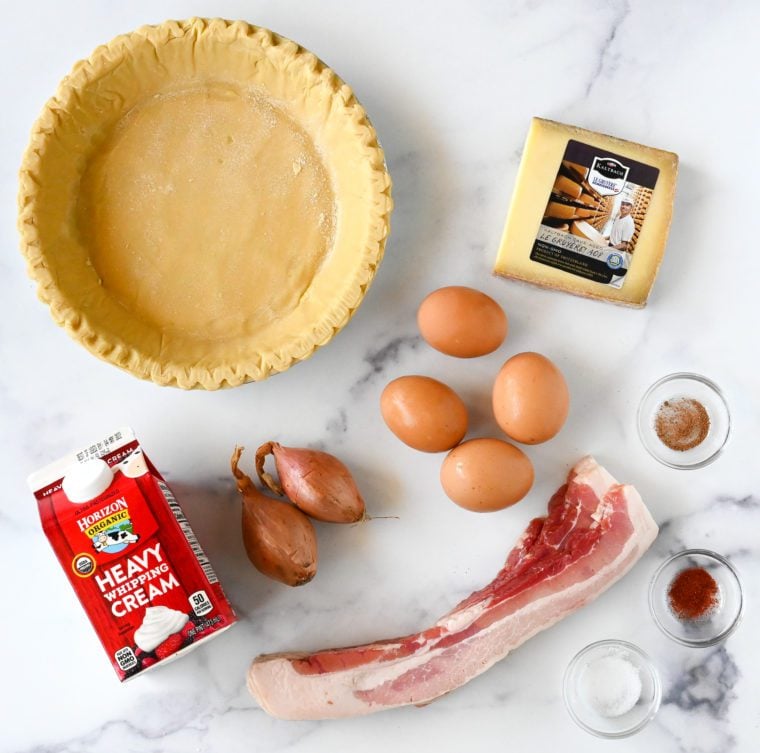
- Frozen pie crust: Serves as the base for the quiche. I recommend using frozen crusts over rolled refrigerated crusts—they are ready to cook and won’t shrink during par-baking. Ensure it’s a deep-dish variety to accommodate all the filling.
- Thick-cut bacon: Adds smoky, savory flavor and meaty texture that is quintessential to the flavor profile of quiche Lorraine. To make it easier to work with, pop it in the freezer for 10 minutes or so before cutting.
- Shallots: Offer a mild, slightly sweet flavor that complements the richness of the other ingredients without overpowering them.
- Eggs: Act as the foundation of the custard filling, binding the ingredients together and giving the quiche its signature texture and structure.
- Heavy cream: Contributes to the luxurious, creamy consistency of the filling. When making quiche, I always use heavy cream over milk or half-and-half.
- Salt, cayenne pepper, ground nutmeg: These seasonings flavor of the quiche, with salt balancing the flavors, cayenne pepper adding a slight heat, and ground nutmeg providing a warm, nutty undertone.
- Gruyère: This cheese lends a rich, nutty flavor that is essential to quiche Lorraine. Use an authentic Swiss-made Gruyère with the AOP seal for the best flavor and quality, and be sure it’s finely shredded so that it melts easily. It’s a bit pricey, but you only need 4 ounces. Plus, any leftover cheese can be used for making delicious grilled cheese sandwiches.
- Jump to the printable recipe for precise measurements
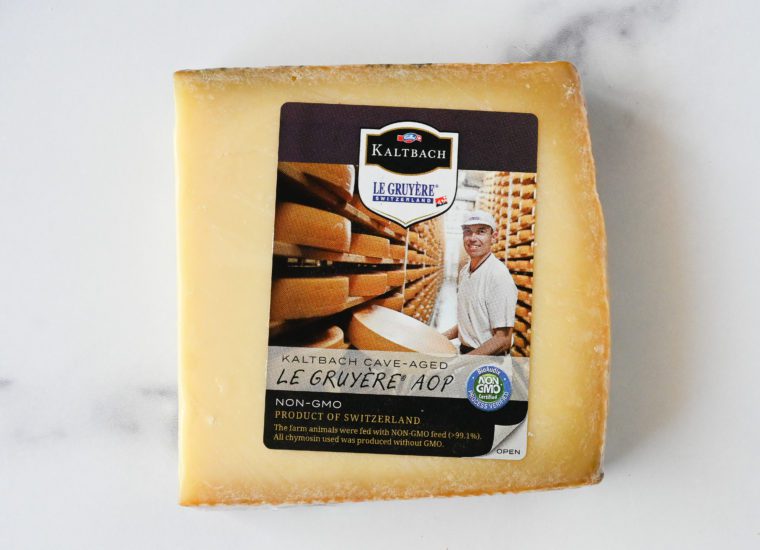
Step-by-Step instructions
To begin, remove the pie crust from freezer and thaw for about 10 minutes. Prick the bottom and sides all over with a fork.
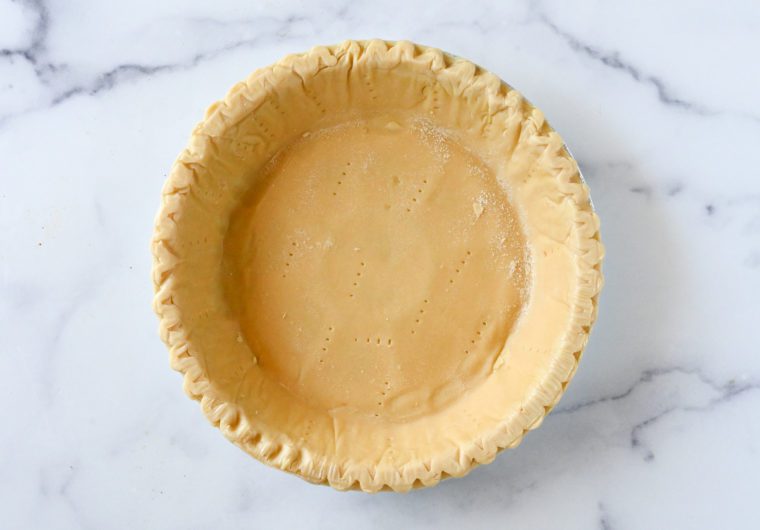
Bake on until lightly golden, 10 to 15 minutes. (Keep an eye on it; if it puffs up while cooking, gently prick it with a fork so it will deflate.) Don’t panic if your crust cracks in the oven. You can easily fix it by making a smooth paste from 1 tablespoon of flour and 1 tablespoon of water. Using your fingers, patch up and fill any cracks with the paste, then place the crust back in the oven for a minute or so to set. It should be good as new.
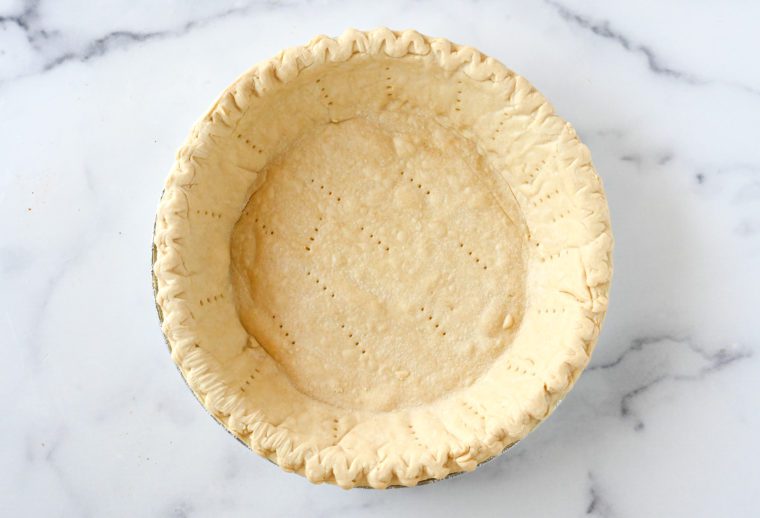
While the crust cooks, dice the bacon. Place the diced bacon in a medium nonstick sauté pan over medium heat. Cook, stirring occasionally, until crisp, about 10 minutes.
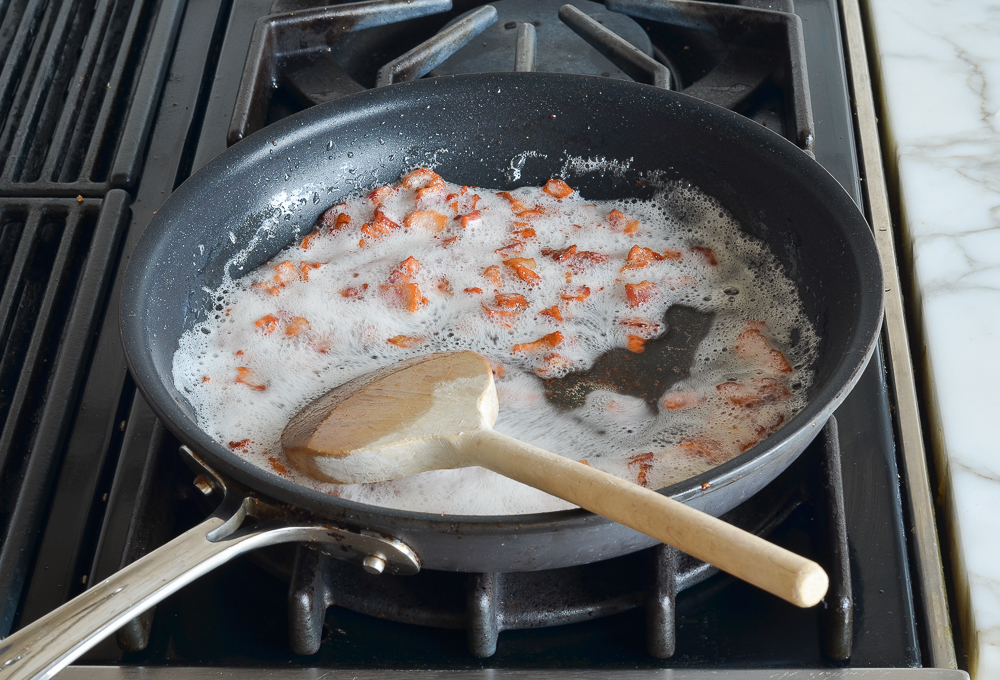
Use a slotted spoon to transfer the bacon to a paper towel-lined plate to drain.
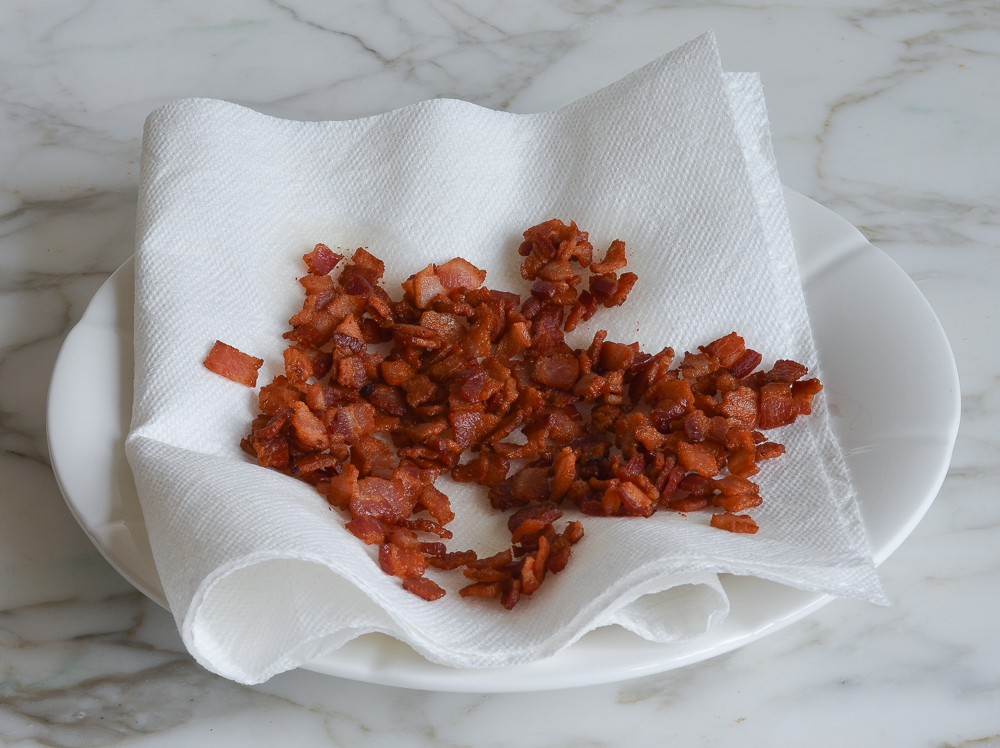
Pour off all but one tablespoon of fat from the pan and add the shallots.
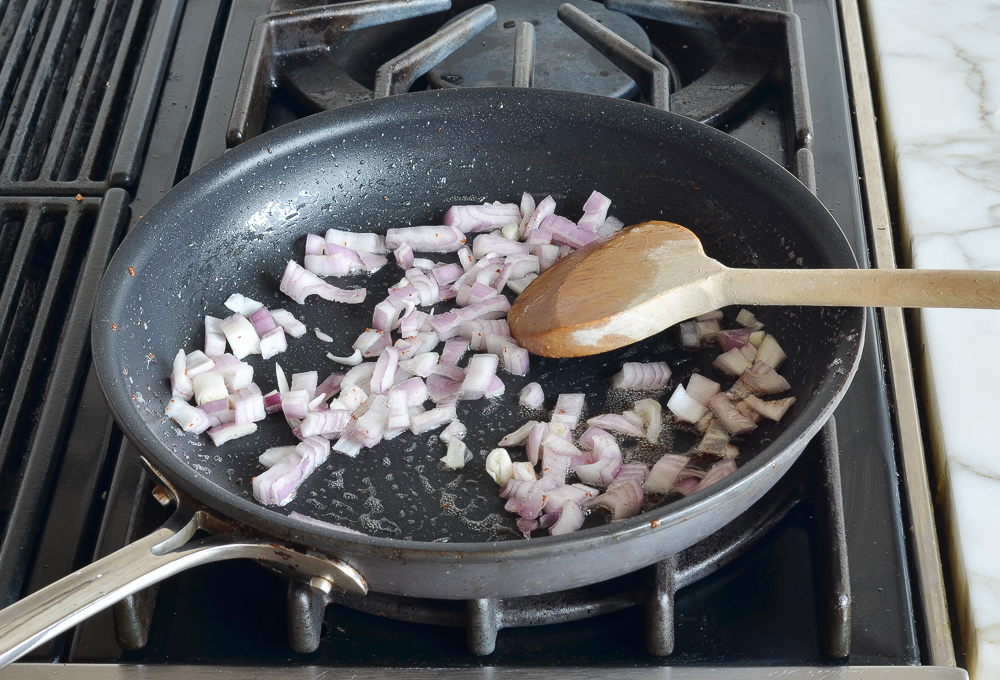
Cook over medium-low heat until soft and translucent, 3 to 4 minutes. Do not brown. Set aside.
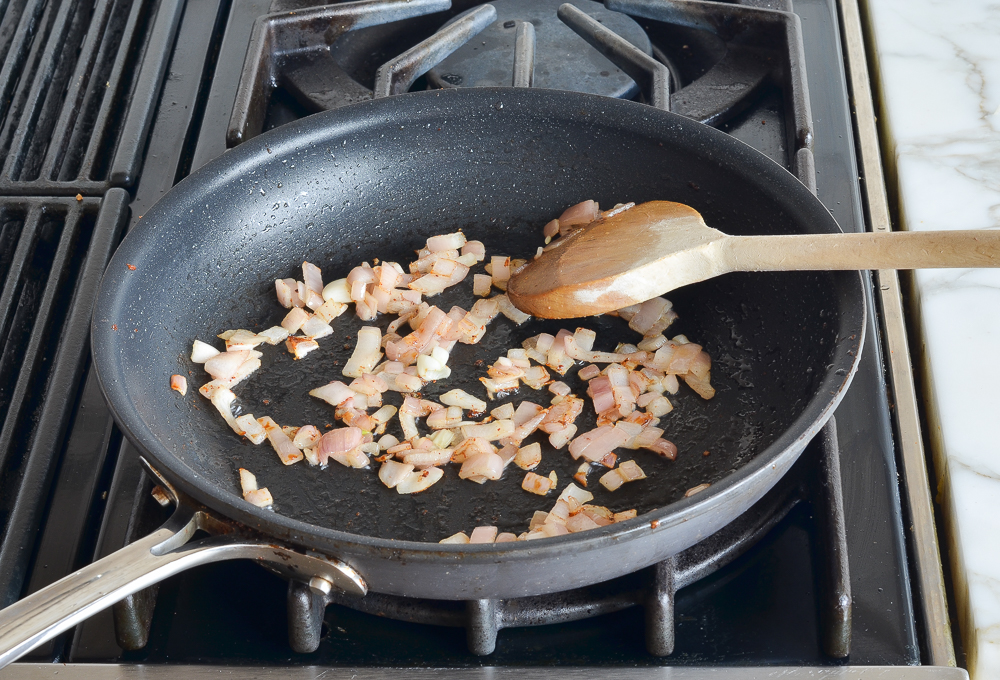
In a medium bowl, whisk the eggs, and then the heavy cream, salt, cayenne pepper, and nutmeg.
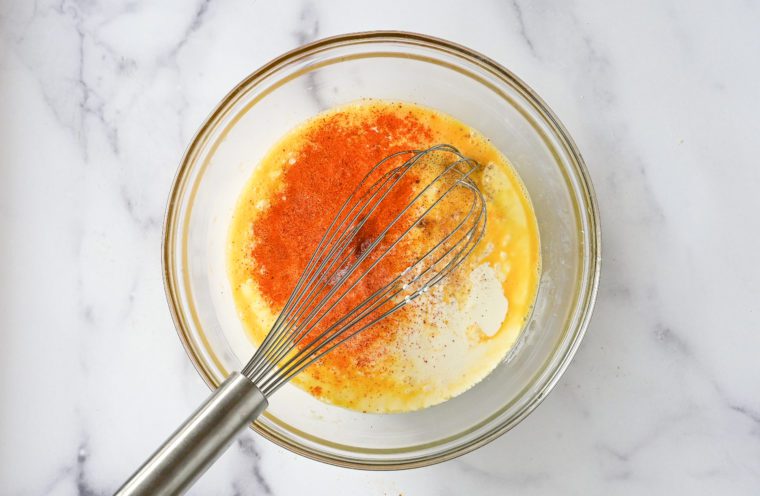
Whisk until evenly combined.
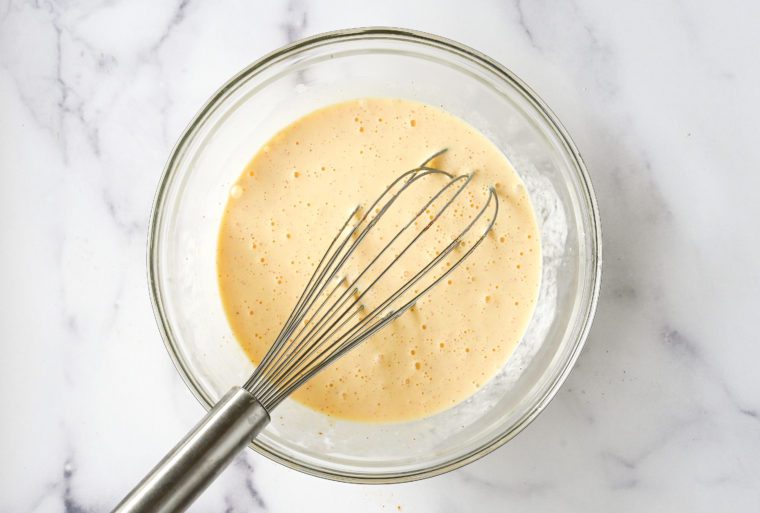
Spread the shallots evenly over the bottom of the cooked crust.
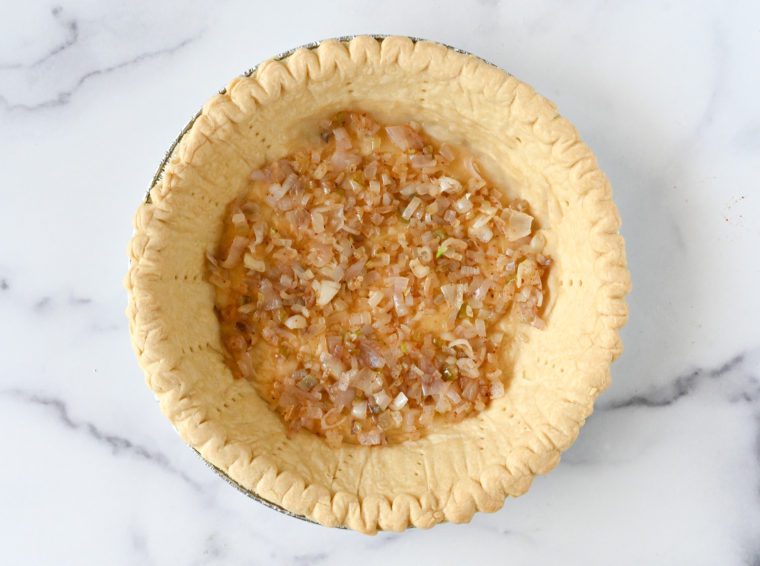
Top with half of the bacon.
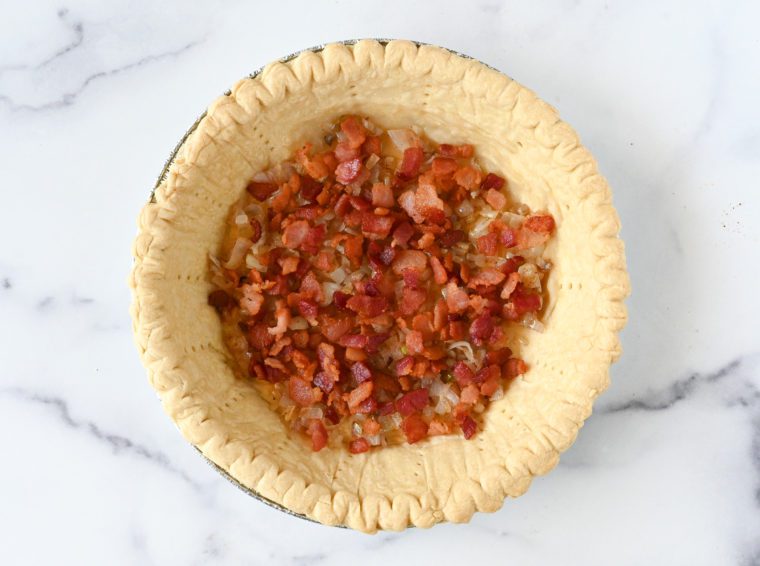
Then all of the Gruyère.
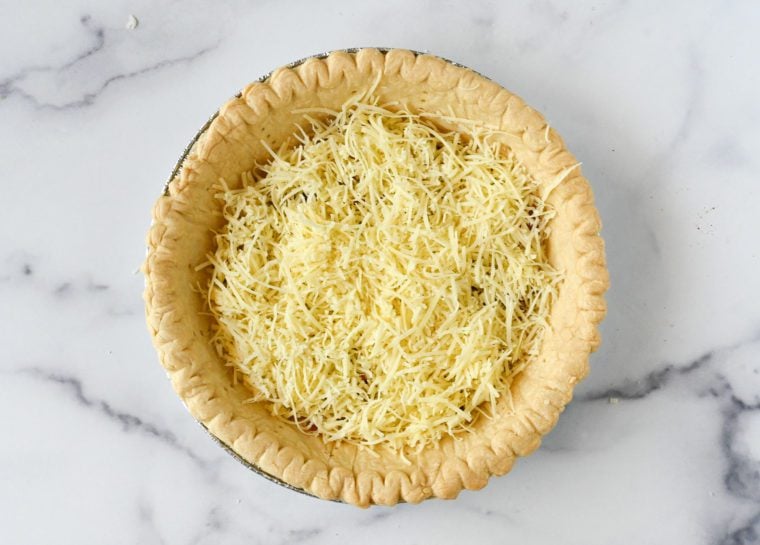
Then the remaining bacon.
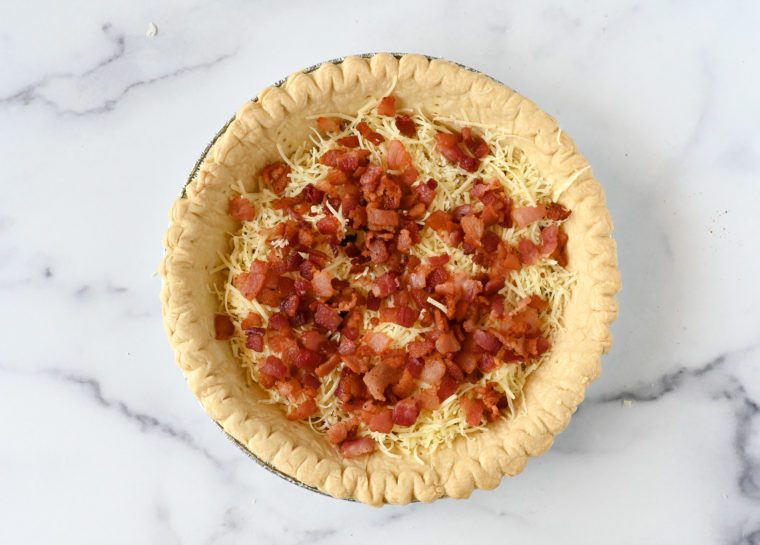
Pour the egg/cream mixture over top.
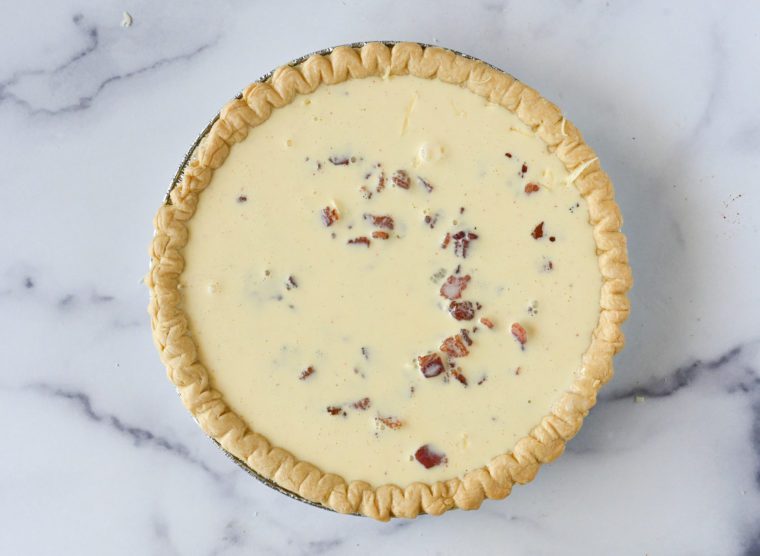
Slide the quiche (still on the baking sheet) into the oven and bake at 325°F for 45 to 50 minutes, until the custard is set and lightly golden. Serve the quiche hot or at room temperature.
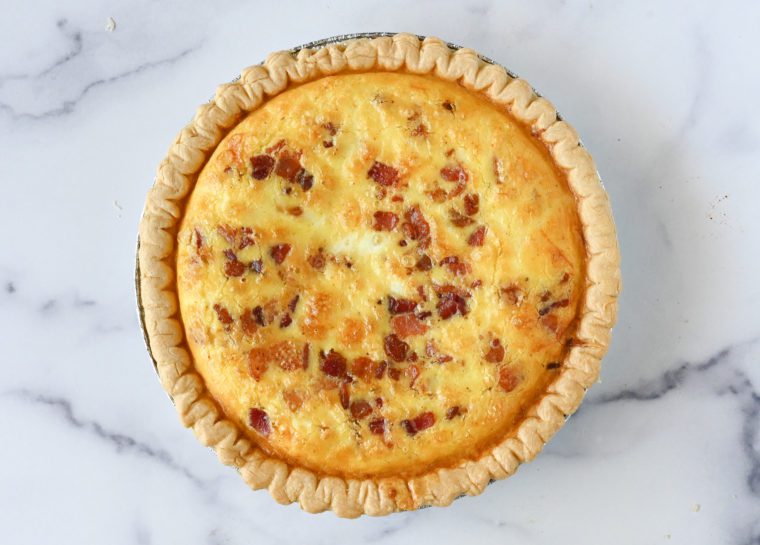
Frequently Asked Questions
Absolutely! You can prepare this recipe a day ahead of time and refrigerate. To reheat, cover the quiche with aluminum foil and heat in a preheated 300°F (150°C) oven for 35 to 45 minutes, or until hot in the center.
Yes, quiche Lorraine freezes beautifully for up to three months. After baking and cooling the quiche, wrap it in a layer of plastic wrap and then a layer of aluminum foil. Remove the quiche from the freezer about 24 hours prior to eating. Remove the plastic wrap and reheat it, covered with foil, in a 300°F oven until hot in the center.
Baking quiche at 325°F is a technique I learned in French culinary school and while working in a French restaurant. This lower temperature prevents the eggs from scrambling, a common issue at higher heats, and ensures the custard sets to a silky smooth consistency. It makes a difference!

Video Tutorial
You May Also Like
Quiche Lorraine
Richly flavored with Gruyère cheese and smoky bacon, quiche Lorraine is one of the most satisfying dishes imaginable.
Ingredients
- One 9-inch deep-dish frozen pie crust
- 8 oz thick-cut bacon (about 6 slices), diced
- ½ cup chopped shallots, from 2 medium shallots
- 4 large eggs
- 1¼ cups heavy cream
- ¼ teaspoon salt
- ⅛ teaspoon cayenne pepper
- Pinch ground nutmeg
- 4 oz Gruyère, finely shredded (about 1¼ cups)
Instructions
- Blind bake the crust: Preheat the oven to 400°F and set a rack in the middle position. Remove the pie crust from freezer and thaw until just soft enough to easily prick with a fork, about 10 minutes. (If there are any cracks in the crust, see note below on how to patch them up.) Prick the bottom and sides all over with a fork. Place the crust on a baking sheet to make it easy to move in and out of the oven. Bake on until lightly golden, 10 to 15 minutes. Keep an eye on it; if it puffs up while cooking, gently prick it with a fork so it will deflate. (If it cracks while baking, see note below for instructions on how to patch it up.) Set aside and reduce the oven temperature to 325°F.
- In a medium nonstick sauté pan over medium heat, cook the bacon, stirring occasionally, until crisp, about 10 minutes. Use a slotted spoon to transfer the bacon to a paper towel-lined plate to drain. Pour off all but one tablespoon of fat from the pan. Add the shallots and cook over medium-low heat until soft and translucent, 3 to 4 minutes. Do not brown. Remove the pan from the heat and set aside.
- In a medium bowl, whisk the eggs. Add the heavy cream, salt, cayenne pepper, and nutmeg; whisk until evenly combined.
- Spread the shallots evenly over the bottom of the cooked crust. Top with half of the bacon, all of the Gruyère, and then the remaining bacon. Pour the egg/cream mixture over top.
- Slide the quiche (still on the baking sheet) into the oven and bake at 325°F for 45 to 50 minutes, until the custard is set and lightly golden. Serve hot or warm.
- Note: Don't panic if your crust has cracks -- you can easily fix it. Make a smooth paste by mixing 1 tablespoon of flour with 1 tablespoon of water. Use your fingers to patch up and fill any cracks, then proceed with the recipe. If the crust cracks while blind baking, patch it afterwards and place it back in the oven for a minute or so to set. It should be good as new.
- Make-Ahead Instructions: This quiche can be fully prepared up to a day ahead of time and refrigerated. To reheat: Cover the quiche with aluminum foil and heat in a preheated 300°F oven for 35 to 45 minutes, or until hot in the center.
- Freezer-Friendly Instructions: The cooked quiche can be frozen for up to 3 months. After baking and cooling the quiche, wrap it in a layer of plastic wrap and then a layer of aluminum foil. Remove the quiche from the freezer about 24 hours prior to eating. Remove the plastic wrap and reheat it, covered with foil, in a 300°F oven for 35 to 45 minutes, or until hot in the center.
Nutrition Information
Powered by ![]()
- Per serving (6 servings)
- Calories: 616
- Fat: 51 g
- Saturated fat: 24 g
- Carbohydrates: 24 g
- Sugar: 3 g
- Fiber: 1 g
- Protein: 16 g
- Sodium: 575 mg
- Cholesterol: 232 mg
This website is written and produced for informational purposes only. I am not a certified nutritionist and the nutritional data on this site has not been evaluated or approved by a nutritionist or the Food and Drug Administration. Nutritional information is offered as a courtesy and should not be construed as a guarantee. The data is calculated through an online nutritional calculator, Edamam.com. Although I do my best to provide accurate nutritional information, these figures should be considered estimates only. Varying factors such as product types or brands purchased, natural fluctuations in fresh produce, and the way ingredients are processed change the effective nutritional information in any given recipe. Furthermore, different online calculators provide different results depending on their own nutrition fact sources and algorithms. To obtain the most accurate nutritional information in a given recipe, you should calculate the nutritional information with the actual ingredients used in your recipe, using your preferred nutrition calculator.

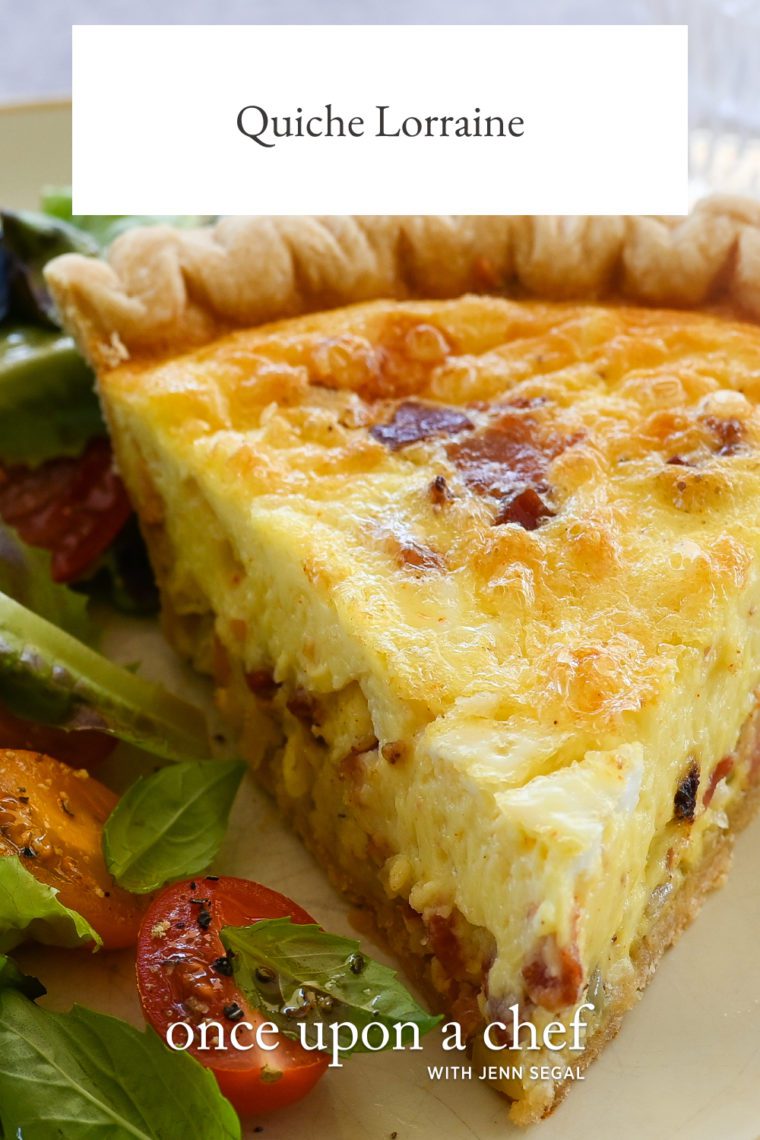
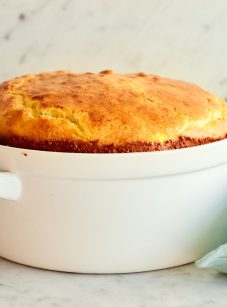


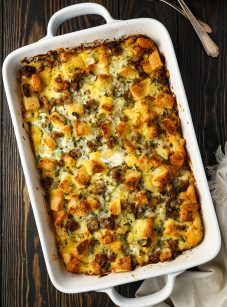
My mother always used evaporated milk instead of cream. A lot less fat—will the quality be compromised much? What about fat free half and half?
Hi Theresa, If you want an alternative to the cream, I’d go with the half and half. It won’t be quite as rich but will still be good. Enjoy!
Jenn I plan on making these in regular sized muffin tins with store bought dough. Do I need to alter the cooking time or recipe?
Hi Cathy, I believe the only change would be the cooking time; I’d cook them for 25 – 30 minutes or until the eggs are set. Please LMK how they turn out!
This recipe looks wonderful! So looking forward to trying. Is there a particular brand of bacon that you recommend using?
Hi Marie, I usually use Smithfield. Hope you enjoy!
Excellent! Made this and the blueberry muffins for friends over for NFL brunch. Everyone loved both 😋
Will definitely be making again.
Absolutely fabulous recipe. I have tried several quiche recipes and have never had results like this! Thank you!
Went to a friends cabin and we offered to provide brunch. I made this quiche exactly as written in the recipe and it was WONDERFUL! TASTED DELICIOUS!
Will definitely make again!
This was spectacular! I adore Quiche Lorraine but this was my first time making it. And it did not disappoint — far from it. The recipe was easy to follow and the results were absolutely delicious. I’ll definitely be making this again (and again and again and again). Thanks!
🙂 Glad you enjoyed it!
Hi Jen,
I just made your recipe for Quiche Lorraine and it was absolutely delicious!
I think it’s the best tasting quiche I’ve ever had. As always, your recipes work out perfectly. Kudos to you for testing them so thoroughly!
Many thanks and kind regards,
Sydney
Hi Jenn! Thank you for the lovely recipe as always – your recipes are my favorite!
A few quick questions for you as I refine my technique, as mine have been turning out slightly differently each time (I’m not sure if it’s an oven issue or something I’m doing): Is there a reason why you layer in the fillings, cheese, and dairy in this and the spinach quiche recipe, but mix the cheese with the dairy in the Parmesan & Leek Quiche? After baking, should the custard portion of these quiches have air bubbles at all?
For context, I’ve had one try come out super smooth (like jello), and others have more holes throughout (like steamed egg custards in Asian cuisine). Both taste great, but I prefer the former as it reminds me of a memorable quiche from a local bakery. I haven’t been to France so I wasn’t sure what the “right” answer is, and the internet doesn’t seem to know either.
Hi SY, Glad you enjoy the recipes! The reason the cheese is mixed in with the Parmesan and Leek quiche is that the cheese is finely grated and easier to incorporate. (That wouldn’t work with finely shredded Gruyere; it would clump up and sink to the bottom of the bowl.) The custard shouldn’t have air bubbles. Are you using full-fat cream? If so, it may be that your oven is too hot.
Ah, that makes sense.
On the dairy, I’ve been using half-and-half, so I wonder if that’s it? Though to be fair, I’ve gotten both the silky custard and the air bubbles one from half-and-half. Could it be a whisking thing?
Hi SY, The fact that you’ve used half-and-half as well as heavy cream makes me suspect that that’s not the problem. My guess is that you could be over whisking the mixture (but for the best results I’d stick with the heavy cream).
Makes sense – thanks, Jenn!
Hi,
I made a batch of Creme Fraiche to go with dessert tomorrow. I’ll have plenty leftover. Can I can use it in you recipe for Quiche Lorraine in lieu of the heavy cream?
By the way, I keep making your blueberry/strawberry muffins any chance I get. We are addicted!
Thank you 😊
Hi Gergana, I’ve never tried this recipe with crème fraîche, but I think it should work. I’d love to know how it turns out if you try it. 🙂